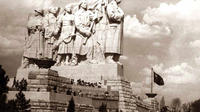Small-Group Half-Day Cold War Years Walking Tour in Prague
Prague, Czech Republic
Trip Type: Walking Tours
Duration: 3 hours
Explore the Hall of the Red Army in a 3-hour walking tour in Prague and also visit the mausoleum that displayed the mummy of Klement Gottwald, first chairman of the KSC, the adjoining laboratory and temperature control center, and numerous sites that show the life of Prague under totalitarianism.
More About This Activity All Walking Tours →
Explore the Hall of the Red Army in a 3-hour walking tour in Prague and also visit the mausoleum that displayed the mummy of Klement Gottwald, first chairman of the KSC, the adjoining laboratory and temperature control center, and numerous sites that show the life of Prague under totalitarianism.
Explore the decorations and statuary of The Hall of the Red Army, created on the site after the communists took power in the “elegant coup” of 1948, we discuss the heavy-handed propaganda strategies of the Communist Party of Czechoslovakia (KSC).
Visit the mausoleum that displayed the mummified corpse of Klement Gottwald, first chairman of the KSC, along with the adjoining laboratory and temperature control center, where a team of doctors, cosmetologists and technicians cared for the embalmed body. Vitkov Hill was already home to the largest equestrian statue in the world, monument to the undefeated 15th century Hussite general Jan Žižka, which was erected to honor the WWI Legionnaires who fought for an independent Czechoslovakia. To gain legitimacy, the KSC persistently used this tactic of linking their icons to Czech nationalism. Take in a panorama of the city and the Žižkov Television Tower, an example of high-tech architecture that looms above the rest of the city’s skyline, while standing atop Vitkov Memorial. When construction began in 1985, rumors circulated that it was designed to jam Radio Free Europe.
Returning to the city center, you visit key sites that focus our discussion on the life of Prague residents under totalitarianism. You look out on Letna Hill where the world’s largest Stalin statue once stood, staring down menacingly on the city. Ashamed for accepting the commission, sculptor Otakar Švec committed suicide three weeks before the colossus was unveiled. At the famed John Lennon Wall, you contemplate the site where poems, pictures, complaints and hopes were scrawled by individuals yearning for freedom. Each time the police had the wall painted over, Czechs risked imprisonment to put up this “graffiti of protest” anew. Perhaps the most symbolic structure of the totalitarian regime is the National Assembly building erected in 1972 as the seat of the communist government. A unique example of the “Socialist Brutalist” architectural style, the building was constructed as a titanic arch over the former Prague Stock Exchange, visually representing the triumph of socialism over the First Republic’s market economy.
From here you visit Wenceslaus Square, the point of convergence for the Warsaw Pact tanks that crushed the Prague Spring of 1968, ending the 8-month period when freedom of speech and of the press blossomed. By the end of the tour, you’ll have a broad picture of the rise of communism in Czechoslovakia and of the consequences and key events of the Velvet Revolution, which ended the long Cold War era and swept Vaclav Havel, a dissident playwright and a prisoner of conscience, to the presidency of today’s liberal democracy, which is still recovering from the social and economic effects of totalitarianism.
Visit the mausoleum that displayed the mummified corpse of Klement Gottwald, first chairman of the KSC, along with the adjoining laboratory and temperature control center, where a team of doctors, cosmetologists and technicians cared for the embalmed body. Vitkov Hill was already home to the largest equestrian statue in the world, monument to the undefeated 15th century Hussite general Jan Žižka, which was erected to honor the WWI Legionnaires who fought for an independent Czechoslovakia. To gain legitimacy, the KSC persistently used this tactic of linking their icons to Czech nationalism. Take in a panorama of the city and the Žižkov Television Tower, an example of high-tech architecture that looms above the rest of the city’s skyline, while standing atop Vitkov Memorial. When construction began in 1985, rumors circulated that it was designed to jam Radio Free Europe.
Returning to the city center, you visit key sites that focus our discussion on the life of Prague residents under totalitarianism. You look out on Letna Hill where the world’s largest Stalin statue once stood, staring down menacingly on the city. Ashamed for accepting the commission, sculptor Otakar Švec committed suicide three weeks before the colossus was unveiled. At the famed John Lennon Wall, you contemplate the site where poems, pictures, complaints and hopes were scrawled by individuals yearning for freedom. Each time the police had the wall painted over, Czechs risked imprisonment to put up this “graffiti of protest” anew. Perhaps the most symbolic structure of the totalitarian regime is the National Assembly building erected in 1972 as the seat of the communist government. A unique example of the “Socialist Brutalist” architectural style, the building was constructed as a titanic arch over the former Prague Stock Exchange, visually representing the triumph of socialism over the First Republic’s market economy.
From here you visit Wenceslaus Square, the point of convergence for the Warsaw Pact tanks that crushed the Prague Spring of 1968, ending the 8-month period when freedom of speech and of the press blossomed. By the end of the tour, you’ll have a broad picture of the rise of communism in Czechoslovakia and of the consequences and key events of the Velvet Revolution, which ended the long Cold War era and swept Vaclav Havel, a dissident playwright and a prisoner of conscience, to the presidency of today’s liberal democracy, which is still recovering from the social and economic effects of totalitarianism.
« Go Back

